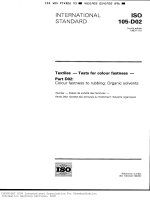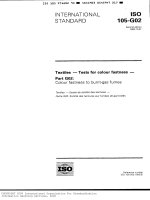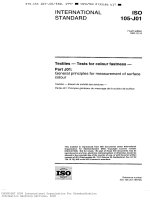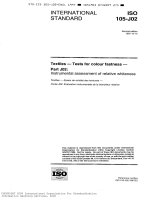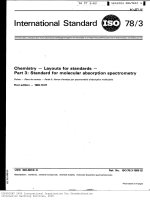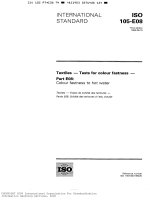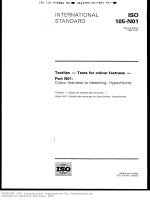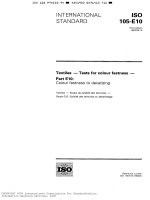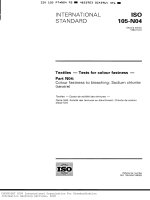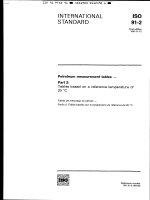Tiêu chuẩn iso 00683 9 1988 scan
Bạn đang xem bản rút gọn của tài liệu. Xem và tải ngay bản đầy đủ của tài liệu tại đây (805.94 KB, 16 trang )
INTERNATIONAL
STANDARD
IS0
683-9
First edition
1988-12-01
INTERNATIONAL
ORGANIZATION
ORGANISATION
INTERNATIONALE
MEX,QYtiAPO,4HAR
Heat-treatable
steels -
steels,
Part 9 :
Wrought free-cutting
OPrAHM3A~MR
FOR STANDARDIZATION
DE
n0
NORMALISATION
CTAH~~PTLl3A~Wl
alloy steels and free-cutting
steels
Aciers pour traitement thermique, aciers alli& et aciers pour dkolletage
-
Partie 9: Aciers corroyb pour dtkoiletage
Reference number
IS0 683-9 : 1988 (E)
--`,,,,,``,````,`,`,,``,,,,,,```-`-`,,`,,`,`,,`---
Copyright International Organization for Standardization
Provided by IHS under license with ISO
No reproduction or networking permitted without license from IHS
Licensee=Bogazici University/5964815002, User=ahmadi, rozita
Not for Resale, 05/25/2015 04:56:48 MDT
IS0 993-9 : 19gs (El
Foreword
IS0 (the International Organization for Standardization) is a worldwide federation of
national standards bodies (IS0 member bodies). The work of preparing international
Standards is normally carried out through IS0 technical committees. Each member
body interested in a subject for which a technical committee has been established has
the right to be represented on that committee. International organizations, governmental and non-governmental, in liaison with ISO, also take part in the work. IS0
collaborates closely with the International Electrotechnical Commission (IEC) on all
matters of electrotechnical standardization.
Draft International Standards adopted by the technical committees are circulated to
the member bodies for approval before their acceptance as International Standards by
the IS0 Council. They are approved in accordance with IS0 procedures requiring at
least 75 % approval by the member bodies voting.
International Standard IS0 693-9 was prepared by Technical Committee ISO/TC 17,
Steel.
It cancels and replaces IS0 Recommendation R 693-9 : 1970, of which it constitutes a
technical revision.
Users should note that all International Standards undergo revision from time to time
and that any reference made herein to any other International Standard implies its
latest edition, unless otherwise stated.
@
International
Organization
for Standardization,
1988
0
Printedin Switzerland
--`,,,,,``,````,`,`,,``,,,,,,```-`-`
ii
Copyright International Organization for Standardization
Provided by IHS under license with ISO
No reproduction or networking permitted without license from IHS
Licensee=Bogazici University/5964815002, User=ahmadi, rozita
Not for Resale, 05/25/2015 04:56:48 MDT
IS0 683-9 : 1988 IE)
STANDARD
Heat-treatable
steels, alloy steels and free-cutting
steels --`,,,,,``,````,`,`,,``,,,,,,```-`-`,,`,,`,`,,`---
INTERNATIONAL
Part 9 :
Wrought free-cutting steels
0
2
Introduction
When preparing this part of IS0
come to international agreements
free-cutting steels. The types of
IS0 683 are typical grades only
covered by national standards.
1
683, it was very difficult
on chemical composition
steel given in this part
and other grades may
to
of
of
be
Scope and field of application
IS0 377, Wrought steel samples and test pieces.
-
bars,
-
Part 11: Wrought case-hardening steels.
IS0 1035, Hot-rolled steel bars
-
Part 1: Dimensions of round bars.
-
Part 2: Dimensions of square bars.
-
Part 3: Dimensions of flat bars.
-
Part 4: Tolerances.
bright steel
manufactured from the free-cutting steels listed in table 3 and
supplied in one of the treatment conditions given for the different types of products in table 1, lines 2 and 3, and in one of
the surface conditions given in table 2.
This part of IS0 683 covers three groups of wrought freecutting steels for mechanical purposes as listed in table 3,
namely
a)
not intended for heat treatment,
b)
suitable for case-hardening,
c)
suitable for quenching and tempering.
NOTE
General technical delivery
- Part 1: Direct-hardening unalloyed and low-alloyed
wrought steel in fern? of different black products.
- wire rod and
-
of
IS0 683, Heat-treatable steels, alloy steels and free-cutting
steels
This part of IS0 683 gives the technical delivery requirements for
semi-finished products, e.g. blooms, billets, slabs,
Selection and preparation
IS0 404, Steel and steel products requirements.
1.1
-
References
-
Related
International
Standards
Hardness test -
IS0 6892, Metallic materials -
Tensile testing.
IS0 6329, Steel products -
3
Brinell test.
Definitions and classification.
Definitions
are given in annex C.
1.2
In special cases, variations in these technical delivery requirements or additions to them may form the subject of an
agreement at the time of enquiry and order (see annex BI.
1.3 In addition to this part of IS0 683, the general technical
delivery requirements of IS0 404 are applicable.
Copyright International Organization for Standardization
Provided by IHS under license with ISO
No reproduction or networking permitted without license from IHS
IS0 6506, Metallic materials -
3.1
product forms : See IS0 6929.
3.2
free-cutting steels : In the sense of this part of IS0 683,
steels characterized by good machinability, i.e. high metal
removal rate, essentially obtained by higher than normal contents of sulfur, or sulfur and lead.
Licensee=Bogazici University/5964815002, User=ahmadi, rozita
Not for Resale, 05/25/2015 04:56:48 MDT
IS0 593-9 : 1988 (El
4
Ordering and designation
Designation :
The designation of the product in an order shall cover the
following :
a) the designation of the product form (bloom, bar, wire
rod, etc.) followed by
- either the designation of the dimensional standard
and the dimensions and tolerances selected from this
(see 5.51,
- or the designation of the drawing or any other document covering the dimensions and tolerances required
for the product;
b) if a surface condition other than “hot worked” or a
special surface quality is required :
-
the surface condition (see table 2) and
-
the surface quality (see 5.4);
c)
Bounds :
IS010351
Surface:
PE
Steel :
IS0 683-9 - 35 s 20 -
5
5.1
- 40,OS
x 8OOOL2
u -
IC
Requirements
Manufacturing
process
5.1.1 The manufacturing process for the steel and for the
products is, with the restrictions given by the requirements in
5.1.2 to 5.1.3, left to the discretion of the manufacturer.
5.1.2
Treatment
and surface condition at delivery
a description of the steel comprising
1)
a reference to this part of IS0 683;
2)
the designation of the steel type given in table 3;
3) if a treatment condition other than the untreated
condition is required, the symbol for this other condition
(see table 1, column 3);
In accordance with the. agreements at the time of enquiry and
order, the products shall’be delivered in one of the treatment
and surface conditions listed in tables 1 and 2 respectively.
5.1.3
Cast separation
The steels shall be delivered separated by casts.
4) if a document is required, the symbol for the required type of document (see table 10);
5.2
5) if any supplementary requirements are to be complied with, the symbol and, where necessary, the details
of each supplementary requirement (see annex B).
Chemical
mechanical
composition,
hardness and
properties
5.2.1 Table 1 gives a survey of combinations of usual treatment conditions at delivery, product forms and requirements
according to the tables 3 to 7 (chemical composition, maximum
hardness, mechanical properties).
Example :
To be ordered are :
Hot-rolled round bars,
5.2.2 Mechanical properties for reference test bars of casehardening steels in the simulated case-hardened condition are
given in table 6 for guidance.
according to IS0 10351,
with a nominal diameter of 40,O mm,
with a nominal length of 8 000 mm,
5.3
with a diameter tolerance of +0,40 mm ( = class S of
IS0 1035-41,
with a length tolerance of
IS0 1(x35-4),
+,,$ mm (=
5.3.1
Technological
properties
Machinability
class L2 of
all other tolerances as given in IS0 1035-4, for normal
cases.
Surface
The steels covered by this part of IS0 683 have good
machinability and chip-breaking characteristics. However, the
machinability decreases with increasing carbon, silicon and
manganese contents, while cold-reduction improves the
machinability of the steels not intended for heat-treatment and
steels 10 S 20 and 10 SPb 20.
peeled (symbol PE, see table 2).
5.3.2
Steel
--`,,,,,``,````,`,`,,``,,,,,,```-`-`,,`,,`,`,,`---
according to this part of IS0 683,
Weldability
Because of their high sulfur and phosphorus content, freecutting steels are not normally recommended for welding.
type 35 S 20 (see table 31,
treatment condition:
table 1).
untreated (no symbol or U, see
with an inspection certificate of type IC (see table 10).
Copyright International Organization for Standardization
Provided by IHS under license with ISO
No reproduction or networking permitted without license from IHS
5.4
5.4.1
Surface quality
All products shall have a workmanlike finish.
Licensee=Bogazici University/5964815002, User=ahmadi, rozita
Not for Resale, 05/25/2015 04:56:48 MDT
Is0 663-9 : 1988 (E)
5.4.2 Minor surface imperfections, which may also occur
under normal manufacturing conditions, such as scores
originating in the case of black steel from rolled-in scale, are not
to be regarded as defects.
In addition the document shall include
a) for all elements specified for the steel type concerned,
the results of the cast analysis given by the manufacturer;
b) the results of all inspections and tests made necessary
by supplementary requirements (see annex B);
5.4.3 As long as no International Standard on the surface
quality of steel products is available, detailed requirements
referring to this characteristic shall, where appropriate, be
agreed at the time of enquiry and order.
NOTES
6.2
1 For barsand wire rod includedin this part of IS0 683, a separateInternationalStandardon surfacequalityis under consideration.
2 It is more difficultto detect and eliminatesurfacediscontinuitiesin
coiledproductsthan in cut lengths.This shouldbe taken into account
when agreementson surfacequalityare made.
5.4.4 Removal of surface imperfections by welding is not permitted.
Pending publication of a separate International Standard, the
kind and permissible depth of surface imperfections for removal
should, where appropriate, be agreed at the time of enquiry
and order.
5.5
Shape,
dimensions
and tolerances
The shape, dimensions and tolerances of the products shall
comply with the requirements agreed at the time of enquiry and
order. The agreements shall, as far as possible, be based on
corresponding International Standards, otherwise on suitable
national standards.
NOTE - The following International Standard covers dimensions
and/or tolerancesfor productscoveredby this part of IS0 683 :
- for bars: IS0 1035 parts 1 to
6
c) the symbol letters or numbers relating the test certificates, the test pieces and products to each other.
Inspection,
testing
and
and testing
inspection
6.2.1 Verification
properties
and testing
of the hardness and mechanical
6.2.1.1
The hardness requirements and/or
mechanical
properties given for the relevant treatment condition in table 1,
column 8, sub-column 2, shall be verified, with the following
exception. The requirements given in footnotes 1 and 2 to
table 1 (mechanical properties of reference test pieces), shall
only be verified if the supplementary requirement given in
annex B, clause B.l or 8.2. is invoked.
6.2.1.2
The amount of testing, the sampling conditions and
the test methods to be applied for the verification of compliance with the requirements shall be in accordance with the
prescriptions in table 11.
6.2.2
Visual and dimensional
conformity
of
procedures
and types
6.1.1 Table 10 gives a survey of the inspection procedures
and the types of document in IS0 404 which may be agreed at
the time of enquiry and order for deliveries according to this
part of IS0 683.
6.1.2 If in accordance with the agreements at the time of enquiry and order a test report (TR) is to be provided, this shall include
a) a statement that the material complies with the requirements of the order, and
b) the results of the cast analysis for all elements specified
for the steel type supplied.
A sufficient number of products shall be inspected to ensure
compliance with the specification.
6.2.3
Retests
6.2.3.1
Where for one or more test units one or more tests
give unsatisfactory results, the manufacturer has the choice of
withdrawing the test units concerned (for example for retreatment or sorting in accordance with IS0 404) or maintaining them. If they are maintained, retests shall be carried out according to the following rules.
6.2.3.2
If - as in the case of product analysis (see annex B,
clause 8.3) - only one test of the type concerned was carried
out on the sample concerned and gave the unsatisfactory
result, two new tests of the same type shall be carried out.
6.2.3.3
If the test unit consists of more than one product and
if the product from which the unsatisfactory test result stems is
not withdrawn from the test unit, one of the two new tests
shall be made on test pieces taken from the sample or product
originally tested.
6.2.3.4 All retests shall give satisfactory results. Otherwise
the test unit concerned shall be rejected.
7
6.1.3 If in accordance with the agreements in the order an inspection certificate (IC or ICP) or an inspection report (IR) (see
table 10) is to be provided, the specific inspections and tests
described in 6.2 shall be carried out and their results shall be
certified in the document.
Marking
The manufacturer shall mark the products or bundles or boxes
containing the products in a suitable way, so that the identification of the cast, the steel type and the origin of the delivery is
possible (see annex B, clause 8.4).
--`,,,,,``,````,`,`,,``,,,,,,```-`-`,,`,,`,`,,`---
Copyright International Organization for Standardization
Provided by IHS under license with ISO
No reproduction or networking permitted without license from IHS
inspection
4.
products
6.1
Inspection
of document
Specific
Licensee=Bogazici University/5964815002, User=ahmadi, rozita
Not for Resale, 05/25/2015 04:56:48 MDT
IS0 693-9 : 1988 (E)
Table 1 -
1
Combinations
2
of usual heat-treatment
conditions at delivery, product forms and requirements
according to tables 3 to 7
4
3
6
a
7
6
x = Applicable
Applicable
for
Heat1
8.1
‘,~~~~i~nt
Symbol
billets
blooms
slabs
at delivery
2
Untreated
(as rolled or
as peeled)
None
or U
wire
rod
bars
x
X
bright
steel
8.2
Normal
requirement
class
Special requirement
X
x
3
Cold drawn
4
Others
Verification
-
C
-
-
Chemical
composition
according to
tables 3 + 4
of the values given in table 6 for simulated-hardened
Maximum
Brine11
hardness according to
Mechanical
properties
in the colddrawn condition according to
X
Other treatment conditions, for example the stress relieved condition
the time of enquiry and order.
reference
class
8.2.2
8.2.1
Chemical
composition
according to
tables 3 + 4
1)
requirements
or the quenched
table 5 in the case of steels not
intended for heat-treatment
or
table 6 in the case of case-harderring steels.‘) or table 7 in the
case of steels for quenching and
tempering*)
table 5 in the case of steels not
intended for heat-treatment
or
table 6 in the case of case-hardening steels” or table 7 in the
case of steels for quenching and
tempering2r
+ tempered
condition,
may be agreed at
test bars may be agreed at the time of enquiry and order (see annex B,
clause B .2).
2)
The mechanical
properties specified in table 7 for the quenched
+ tempered
condition shall be achievable
after appropriate
heat treatment
if so agreed at
the time of enquiry and order (see annex B, clause B.l).
Table 2 1
I
2
Surface
3
condition
1
As hot worked
3
+ peeled
4
Cold drawn
5
Others
In addition,
I5
I6
I
I7
a
I
Symbol
WI-1
None
or HW
I
PE
I
C
Notes
X
X
I
-
I
-
-
-
X
I
I
I
-
I
x
X
I
1)
it may be agreed that the products are oiled.
--`,,,,,``,````,`,`,,``,,,,,,```-`-`,,`,,`,`,,`---
1)
1 HW
I4
at delivery
/
2
Surface condition at delivery
4
Copyright International Organization for Standardization
Provided by IHS under license with ISO
No reproduction or networking permitted without license from IHS
Licensee=Bogazici University/5964815002, User=ahmadi, rozita
Not for Resale, 05/25/2015 04:56:48 MDT
IS0 693-9 : 1989 (El
Table 3 Type of steelz)
Types of steel, chemical
Si %
C%
I
Steels
9s20
11 SMn
28
11 SMnPb
12 SMn
28
35
12 SMnPb
35
composition
fapplicable
Mn %
not intended
for heat
P %
s %
Pb %
treatment
I ,204)
-
1
max. 0.13
max. 0,053)
0.60
2
max. 0,14
max. 0.0531
0,90 to 1,30
max. 0.11 s)
max. 0,115)
0,15 to 0.25
0,24 to 0,33
2 Pb
3
max. 0.14
max. 0,15
max. 0,053)
max. 0.053)
0,90 to 1.30
1,Ocl to 1.50
max. 0,ll s)
max. 0,115)
0.24 to 0.33
0.30 to 0,44l
0,15 to 0,356)
-
3 Pb
max. 0.15
max. 0.053)
1.00 to I,50
max. 0,115)
0,30 to 0.40
0,15 to 0,35 6)
0.07 to 0,13
0,15 to 0,40
0,70 to 1,lO
max. 0.06
0.15 to 0,25
-
0,07 to 0.13
0,14 to 0,20
0,15 to 0.40
0,15 to 0,40
0.70 to 1.10
1.20 to 1,60
max. 0.06
max. 0.06
0,15 to 0.25
0,15 to 0,25
0.15 to 0,356’
-
Case-hardening
t0
to cast analysisll)
1
-
steels71
--`,,,,,``,````,`,`,,``,,,,,,```-`-`,,`,,`,`,,`---
Direct-hardening
steels’)
6)
36 s 20
7
0.32 to 0.39
0,15 to 0.40
0,70 to I,10
max. 0.06
0,15 to 0.25
36 SMn 20
44SMn28
8
-
0,32 to 0.39
0,15 to 0.40
0,90 to 1,40
max. 066
0,15 to 0,25
6)
0,40 to 0.48
0,15 to 0,40
I,30
to 1,70
max. 0,06
0.24 to 0.33
6)
46 s 20
10
0,42 to 0.50
0,15 to 0,40
0,70 to 1.10
max. 0.06
0,15 to 0,25
8)
1) Elements not quoted in this table should not be intentionally added to the steel without the agreement of the purchaser, other than for the purpose of finishing the heat. However, unless otherwise agreed, the manufacturer may add elements such as Ca, Te, etc., for the purpose of improving
the machinability.
2)
Numbers
used previously in ISO/R
693-9 : 1970 are given in the right-hand
3)
Since silicon has an adverse effect on machinability,
4)
An Mn content
of 0.50
it is not intentionally
column.
added to specified
limits.
% min. may be agreed at the time of enquiry and order.
5)
At the time of enquiry and order, it may be agreed that either a grade with 0,06 to 0,ll
6)
Applicable
% P or a grade with max. 0.05 % P shall be delivered.
to product analysis.
7) Where toughness is of importance, steels with a lower sulfur range or other means, for example lead addition or a controlled shape of the sulfides,
may be employed (see footnote 5 to table 3 of IS0 683-l and footnote 3 to table 3 of IS0 683-11).
8)
Lead additions
may be agreed at the time of enquiry and order.
Table 4 -
Element
Permissible
deviations
Permissible
according
between
specified analysis and product analysis
maximum
content
to cast analysis
Permissible
% ImImI
% h/m)
C
Si
< 0,30
> 0.30
< 0,50
> 0.05
< 0.40
*
I
< 0,05
I
0.02
k 0,03
f
0,Ol
*
0.03
0,04
<
I,00
t
> 1.00
<
1.70
ItI 0,06
< 0.06
*
> 0.06
< 0,ll
It 0.02
< 0.33
k 0,032)
< 0,40
I? 0,04
Mn
P
S
> 0.33
1)
deviations”
+ means that in one cast the deviation
0,008
may occur over the upper value or under the lower value of the
specified range in table 3, but not both at the same time.
2)
A permissible deviation
Copyright International Organization for Standardization
Provided by IHS under license with ISO
No reproduction or networking permitted without license from IHS
+ o
OJX
_
o3 % S for steel type 9 S 20 may be agreed at the time of enquiry and order.
Licensee=Bogazici University/5964815002, User=ahmadi, rozita
Not for Resale, 05/25/2015 04:56:48 MDT
5
IS0 663-9 : 1966 (E)
Table 5 -
Mechanical
properties of free-cutting
steels not intended for heat-treatment
1)
--`,,,,,``,````,`,`,,``,,,,,,```-`-`,,`,,`,`,,`---
11 SMn 26
11 SMnPb 28
12 SMn 35
R, = yield stress 10,2 % proof stress);
1)
R,
A
2)
= tensile strength;
= percentage elongation
The mechanical
after fracture
(Ia = 5 da).
properties in the cold-drawn
condition can vary depending
ing, Therefore, these values shall be regarded as applicable unless otherwise
very high cold-drawing rates may adversely affect the machinability.
Table 6 -
Mechanical
on the starting properties of the bars and on the amount of cold draw-
agreed.
If such agreements
properties of case-hardening
are made, it shall be taken into account that
free-cutting
steelslj
As rolled
Simulated
Cold drawn*)
Type
of steel
mm
< 16
10 SPb
HB max.
N/mm2
A
min.
%
490 to 790
8
149
44Oto740
9
>40<63
149
390 to 690
10
20
26
R,
159
< 16
17 SMn
Hardness
>16<40
10 s 20
179
530 to 830
6
>16<40
170
490 to 790
7
>40<63
170
470 to no
a
1)
R, = yield stress (0,2 % proof stress);
R, = tensile strength;
A = percentage elongation after fracture f/a = 5 da).
2)
The mechanical
properties in the cold-drawn
condition can vary depending
ing. Therefore, these values shall be regarded as applicable unless otherwise
very high cold-drawing rates may adversely affect the machinability.
3)
The values are for guidance
case hardened3)
As iieled
Diameter
4
min.
R,
mm
N/mm*
N/mm2
16
270
450to
800
12
30
250
400 to
700
13
16
500
750t01100
30
400
6ooto
min.
%
9
900
10
on the starting properties of the bars and on the amount of cold drawIf such agreements are made, it shall be taken into account that
agreed.
only.
6
Copyright International Organization for Standardization
Provided by IHS under license with ISO
No reproduction or networking permitted without license from IHS
A
Test bar
Licensee=Bogazici University/5964815002, User=ahmadi, rozita
Not for Resale, 05/25/2015 04:56:48 MDT
IS0 693-9 : 1988 (El
Table 7 -
Mechanical
properties of direct-hardening
As rolled or
As peeled
free-cutting
Cold drawn*!
steelsl)
Quenched
I
and tempered31
Diameter
of steel
Hardness
I
Zn.
1
rZrY.
/
Rm
I
%
1
N/mm*
1
N/mm2
1
6
1
390
I
1
335
1
1
r-AI.
%
880
192
Mot0
740
8
192
510 to
710
9
305
490 to 690
17
205
610 to
906
6
420
620 to 820
14
>16<40
580to
780
>40<63
560to
760
241
44SMn28
46S20
11
/
590to
< 16
t
N/mm*
197
36 s 20
35SMn20
Rm
HB max.
mm
750to1040
570tono
I
14
54Oto740
1
16
8
1
365
1
590 to 790
1
16
I
9
I
335
I
540to740
I
17
I
5
I
530
I
750to950
I
10
241
720 to
920
7
1
490
1
710 to910
I
11
241
700 to
900
8
1
456
1
670 to 870
1
12
229
690to
986
5
1
456
I
650to860
I
11
223
64Oto
830
7
1
380
I
610 to 810
1
13
223
610to
806
8
I
345
I
570 to 770
I
14
I
I
--`,,,,,``,````,`,`,,``,,,,,,```-`-`,,`,,`,`,,`---
Type
R, = yield stress (0.2 % proof stress);
R, = tensile strength;
A = percentage elongation after fracture (Ia = 5 d,,).
2)
The mechanical properties in the cold-drawn condition can vary depending on the starting properties of the bars and on the amount of cold drawing. Therefore, these values shall be regarded as applicable unless otherwise agreed. If such agreements are made, it shall be taken into acount that
very high cold-drawing
3)
When
mechanical
agreed between
rates may adversely affect the machinability.
properties
the purchaser
are specified for the quenched
Table 8 -
Type
of steel
Carburizing
temperature*1
cold-reduced
condition,
values for these shall be
3b
Direct and simple
hardening
temperature
Double
free-cutting
steels’)
hardening
Core hardening
temperature31
Case hardening
temperature
OC
T
OC
830 to 870
880 to 920
780 to 820
Quenching
agent
Tempering51
T
m
880
10 SPb 20
The temperatures
temperatures
to 980
4)
150 to 206
m
17 SMn
1)
and subsequently
Conditions for heat treating of case-hardening
T
10 s
and tempered
and the supplier.
given for carburizing,
direct and simple hardening,
chosen shall be those that will give the properties
core hardening,
case hardening
and tempering
are for guidance;
the actual
required.
2) The carburizing temperature will depend on the chemical composition of the steel, the mass of the product, and the carburizing medium. If the
steels are direct hardened, in general a temperature
of 956 OC is not exceeded.
For special procedures,
for example under vacuum, higher
temperatures,
3)
for example
1 020 to 1 050 OC, are not unusual.
If the steels are direct hardened and if there is a danger of distortion,
case hardening
they shall be quenched
from a temperature
between
the core hardening and
temperatures.
4)
The kind of quenching
5)
Time for tempering
agent depends for example
on the shape of the products,
the cooling conditions
and the quantity
of furnace
filling.
as a guide : 1 h minimum.
Copyright International Organization for Standardization
Provided by IHS under license with ISO
No reproduction or networking permitted without license from IHS
7
Licensee=Bogazici University/5964815002, User=ahmadi, rozita
Not for Resale, 05/25/2015 04:56:48 MDT
IS0 883-9 : 1988 (El
Table 9 -
Type
Conditions for treating
direct-hardening
Quenching*)
Normalizing
of steel
free-cutting
steelsl)
Tempering”)
T
OC
36sm.36sMnm
860 to 890
860 to 890
Water
44SMn28
840 to 870
840 to 870
Oil or water
540 to 680
46 s 20
840 to 870
840 to 870
Oil or water
540 to 680
1) The temperatures are for guidance,
give the properties required.
2)
Time for austenitizing
3)
Time for tempering
Table 10 -
but the actual temperatures
Applicable
inspection
ICP
chosen shall be those that will
procedures and types of document
3
2
Inspection
and testing
Non-specific
testing and inspection’)
Type
procedure
of document
None
Statement
of compliance
Test report
TR
IC
540 to 680
1 h minimum.
SC
T
or oil
as a guide : 0,5 h minimum.
as a guide:
1
Symbol
medium
Specific testing and inspection21
by the competent department at the
manufacturer’s
works
Specific testing and inspection*) in
the presence of the purchaser or a
representative designated by him
IR
Inspection certificate signed by a
representative of the competent
department at the manufacturer’s
works
Inspection certificate signed by
the purchaser or a representative
designated by him
Inspection report signed by
the manufacturer and the purchaser
or his representative
1) Non-specific inspection and testing is inspection and testing carried out by the manufacturer in
accordance with his own procedures, on products made by the same manufacturing process, but not
necessarily on the products
actually supplied.
2)
Specific inspection and testing means the inspection and testing procedure carried out on the
products to be supplied, in order to verify whether these products comply with the requirements of
--`,,,,,``,````,`,`,,``,,,,,,```-`-`,,`,,`,`,,`---
the order.
8
Copyright International Organization for Standardization
Provided by IHS under license with ISO
No reproduction or networking permitted without license from IHS
Licensee=Bogazici University/5964815002, User=ahmadi, rozita
Not for Resale, 05/25/2015 04:56:48 MDT
IS0 883-9 : 1988 (El
Table 11 NOTE -
Verification
Test conditions for verification
of the requirements
of compliance
is only necessary if an inspection certificate
with the various requirements
or an inspection report is ordered and if the requirement
is applicable ac-
cording to table 1, column 8.
1
2
4
3
Amount
Requirements
5
6
7
of testing
Number of
No
Chemical
composition
1
1)
2
Hardness in
the untreated condition
(as rolled or
as peeled)
3
Mechanical
properties
of products
in the colddrawn or
quenched
and tempered condition
sample
products
per test
unit
Test
unit’)
see
table
3+4
C
5 + 6 + 7
(The cast analysis is given by the manufacturer;
C+D+T
5+6+7
Sampling*)
1
13)
C+D+T
Test
method
tests
per sample
product
for product analysis, see annex B, clause B.3)
1
In cases of dispute, the hardness
shall be measured, if possible, at the
circumference of the product at a
distance of 1 x thickness from one
end and in cases of products with
square or rectangular cross-section
at a distance of 0.25 x r-v(width of
the product) from one longitudinal
edge.
According
1
The test pieces for the tensile
test shall be taken in accordance
with figure 1.
The tensile test shall be carried out
in accordance with IS0 6892 on proportional test pieces having a gauge
length of L, = 5.65 S,. (S, = area
of the cross-section of the test
piece.)
to IS0 6506
The tests shall be canied out separately for each cast as indicated by “C”. each dimension as indicated by “D” and each heat treatment
batch as indicated
by “T”.
Products with different
thicknesses
may be grouped
thickness do not affect the properties.
if the thicknesses
2)
The general conditions for selection and preparation
3)
If
3)
lie in the same dimensional
range for mechanical
properties and if the differences
in
In cases of doubt, the thinnest and the thickest product shall be tested.
If the products are continuously
heat treated,
of test samples and test pieces shall be in accordance
with IS0 377.
one sample product shall be taken for each 25 t or part thereof,
but at least one sample product for
each cast.
--`,,,,,``,````,`,`,,``,,,,,,```-`-`,,`,,`,`,,`---
9
Copyright International Organization for Standardization
Provided by IHS under license with ISO
No reproduction or networking permitted without license from IHS
Licensee=Bogazici University/5964815002, User=ahmadi, rozita
Not for Resale, 05/25/2015 04:56:48 MDT
1s0 883-9 : 1988 (E)
Dimensions
/ -. \
i
1 Tensile test piece
\ ./
/’
Circular sections
--`,,,,,``,````,`,`,,``,,,,,,```-`-`,,`,,`,`,,`---
A = Sample
product
B = Test sample
C = Test bar (the piece after reduction
to the size in which it is to be heat treated)
D = Test piece
Rectangular
/
/
\ \I
sections
‘\
\
_-
/
@
Figure 1 -
Copyright International Organization for Standardization
Provided by IHS under license with ISO
No reproduction or networking permitted without license from IHS
10
Location of the test pieces in the products
Licensee=Bogazici University/5964815002, User=ahmadi, rozita
Not for Resale, 05/25/2015 04:56:48 MDT
in millimetres
IS0
Annex
Ruling
sections
693-9 : 1999 (El
A
for the mechanical
properties
(This annex forms an integral part of the Standard.)
A.1
Definition
ruling section of a product: That section for which the
specified mechanical properties shall apply.
Independent of the actual shape and dimensions of the crosssection of the product, the size of its ruling section is always
given by a diameter. This corresponds to the diameter of an
“equivalent round bar”. That is a round bar which, at the position of its cross-section specified for taking the test pieces for
the mechanical t&s,
will, when being cooled from the
austenitizing temperature, show the same cooling rate as the
actual ruling section of the product concerned at its position for
taking the test pieces.
A.2
Determination
ruling section
of the diameter
A.2.1.1
For round bars, the nominal diameter of the product
(not comprising the machining allowances) shall be taken as
the diameter of the ruling section.
A.2.1.2
For hexagons and octagons, the nominal distance
between two opposite sides of the cross-section shall be taken
as the diameter of the ruling section.
A.2.1.3
For square and rectangular bars, the diameter of the
ruling section shall be determined as shown in the example in
figure 2.
A.2.2
For other product forms, the ruling section shall be
agreed at the time of enquiry and order.
of the
A.2.1
If the test pieces are taken from products with simple
cross-sections and from positions with quasi two-dimensional
heat flow, the following shall apply.
--`,,,,,``,````,`,`,,``,,,,,,```-`-`,,`,,`,`,,`---
Copyright International Organization for Standardization
Provided by IHS under license with ISO
No reproduction or networking permitted without license from IHS
11
Licensee=Bogazici University/5964815002, User=ahmadi, rozita
Not for Resale, 05/25/2015 04:56:48 MDT
IS0 993-9 : 1999 (E)
240
220
Quenching in oil
or H rater
-t
200
180
160
E
E
140
+
d 120
Y=
5 100
80
60
40
20
I/
0
1
20
I
I
60
40
I
I
I
I
I
I
80
100
120
140
160
180
I
I
200
220
240
260
I
280
I
I
I
300
320
340
Width, mm
Figure 2 -
Example:
12
For a rectangular
bar with
Diameter
of the ruling section of square and rectangular
a cross-section
of 40 mm
x 60 mm, the diameter
of the ruling
--`,,,,,``,````,`,`,,``,,,,,,```-`-`,,`,,`,`,,`---
Copyright International Organization for Standardization
Provided by IHS under license with ISO
No reproduction or networking permitted without license from IHS
Licensee=Bogazici University/5964815002, User=ahmadi, rozita
Not for Resale, 05/25/2015 04:56:48 MDT
bars
section
is 50 mm.
360
IS0 693-9 : 1988 (E)
Annex
Supplementary
B
or special
requirements
(This annex forms an integral part of the Standard.)
NOTE - One or more of the following supplementary or special requirements shall be applied but only when specified in the enquiry and order. Details
of these requirements shall, where necessary, be agreed upon by the manufacturer and purchaser at the time of enquiry and order.
B.l
Mechanical properties of reference
pieces in the quenched and tempered
condition
test
For deliveries of steels for quenching and tempering, in a condition other than quenched and tempered, the requirements for
the mechanical properties in the quenched and tempered condition (see table 7) shall be verified on a reference test piece.
In the case of bars, wire rods and bright steel the sample to be
quenched and tempered shall, unless otherwise agreed, have
the cross-section of the product. In all other cases, the dimensions and the manufacture
time of enquiry
of the sample
and order where
a reference test piece. The values of table 6 apply to test pieces
taken on simulated case-hardened rounds tested in accordance
with IS0 6892 (tensile test). The details of simulated casehardening shall be agreed.
B.2.2
The reference test bar shall be manufactured by hotforging the test sample to the next-smallest diameter of
reference test bar, i.e: to 16 or 30 mm diameter. The test pieces
shall be taken from the test bar in the longitudinal direction.
The axes of test pieces shall correspond to the axes of 16 mm
and 30 mm test bars.
shall be agreed at the
appropriate,
taking
into con-
sideration the indications for the determination of the ruling
section given in annex A. The samples shall be quenched
and
tempered in accordance with the conditions given in table 9 or
as agreed at the time of enquiry and order. The details of the
heat treatment shall be given in the document. Unless otherwise agreed, the test pieces shall be taken in accordance with
the relevant specifications of the standard.
8.2
Mechanical properties of reference
pieces in the simulated case-hardened
condition
test
B.2.1 The values for the mechanical properties in the simulated case-hardened condition (see table 6) shall be verified on
B.3
Product analysis
One product analysis shall be carried out per cast for the determination of all elements for which values are specified for the
cast analysis of the steel type concerned.
The conditions for sampling shall be in accordance with
IS0 377. In cases of dispute, the analysis shall be carried out, if
possible, according to the appropriate internationally standardized method.
B.4
Special agreements
The products
time of enquiry
shall be marked
for marking
in a way specially
agreed
at the
and order.
--`,,,,,``,````,`,`,,``,,,,,,```-`-`,,`,,`,`,,`---
Copyright International Organization for Standardization
Provided by IHS under license with ISO
No reproduction or networking permitted without license from IHS
13
Licensee=Bogazici University/5964815002, User=ahmadi, rozita
Not for Resale, 05/25/2015 04:56:48 MDT
IS0 883-9 : 1988 (E)
Annex
List of related
C
International
Standards
(This annex does not form an integral part of the Standard.)
International Standards covering types of steel similar to those in table 3, but destined for other products or treatment conditions or
special applications :
IS0 683, Heat-treated steels, alloy steels and free-cutting steels
-
Part 17: Ball and roller bearing steels.
Part 18: Wrought unalloyed steels in the normalized, or normakzed and cold-drawn, or hot-rolled and cold-drawn
condition. 1)
IS0 2939, Hollow steel bars for machining.
IS0 4954, Steels for cold heading and cold extruding.
1)
When
UDC
this part of IS0 683 is revised, the revised standard
will no longer cover the normalized
condition.
669.14.018.23-13
Descriptors
acceptance
: steels,
testing,
heat treatable
designation,
steels,
alloy steels,
free machining
steels,
iron- and steel products,
wrought
marking.
--`,,,,,``,````,`,`,,``,,,,,,```-`-`,,`,
Price based on 14 pages
14
Copyright International Organization for Standardization
Provided by IHS under license with ISO
No reproduction or networking permitted without license from IHS
Licensee=Bogazici University/5964815002, User=ahmadi, rozita
Not for Resale, 05/25/2015 04:56:48 MDT
products,
specifications,
